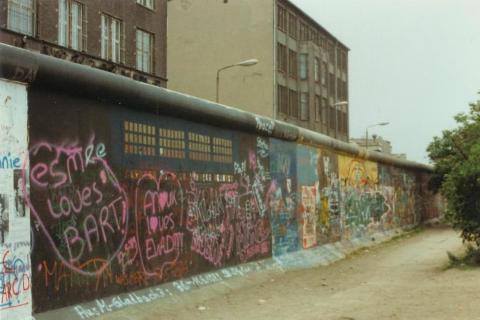By Avani Sihra
Following the end of World War II, the major Allied countries agreed to split Germany into four occupation zones, each of which fell under different leadership: the east by the Soviets and the west by the Americans, the British, and the French. Although the city of Berlin lay completely within the Soviet zone, it too was split into occupation zones, again with the east controlled by the Soviets and the west by the Americans, British, and French.
However, it soon became clear to the Soviets that it would be hard to keep their zones under control so close to a western presence. In 1948, the Soviets blockaded West Berlin, effectively blocking all railways, roads and canals. The Soviets only agreed to end the blockade if West Berlin got rid of the new Deutsche Mark that the West had begun using. Their attempt to rid West Berlin of this new currency, as well as their desire to crush western presence in Berlin, was unsuccessful. The United States, France, and Great Britain launched the Berlin Airlift, in which the western Allies delivered food and supplies to the blockaded citizens of West Berlin. The airlift lasted for about 11 months; in May of 1949, the two sides reached settlements regarding their respective territories.
Following the Berlin Airlift, the city saw relative peace until around 1958. After launching Sputnik, the first artificial satellite, the Soviets had a heightened sense of confidence in their capabilities and wanted to limit the number of citizens departing their zone for the western zone. Since the end of the blockade, around 3 million people had left eastern zones in Germany for western zones. The main reasons people wanted to leave East Berlin centered on the Sovietization of the region: unlike the Americanized, freer society of West Berlin, East Berlin had oppressive laws and policies, including strictly enforced curfews and media censorship.
Because of the mass exodus, Soviet leader Nikita Khrushchev decided that the time had come to erect a wall between the eastern and western portions of Berlin. Thus, in 1961, preliminary construction of the Berlin Wall began. Although the reason cited for the building of the wall stressed the importance of “keep[ing] Western ‘fascists’ from entering East Germany and undermining the social state,” the Soviets were actually trying to keep their citizens in. The wall stood as a virtually impossible structure to breach. One could only get across through certain checkpoints, such as Checkpoint Charlie.
As time passed, a newly improved concrete wall replaced the initial wall. Referred to as the “Death Strip,” the eastern side of the wall was lined with machine guns, bright lights, search dogs, and soldiers. From the building of the wall in 1961 to when it fell in 1989, thousands of people managed to escape East Berlin. Many on the eastern side resorted to desperate measures, such as digging underground tunnels and hiding in suitcases and trunks of vehicles in order to escape East Berlin. Around 200 people died while attempting to get over the Berlin Wall. An example of the global outcry against the brutality of the wall can be seen in President Ronald Reagan’s iconic speech in 1987 calling for the wall to be torn down.
There are many theories regarding the events that led to the wall coming down. Many give credit to President Reagan, saying that his staunch anti-communist attitude and rhetoric led to the fall of the wall, and later, to the fall of the Soviet Union. Others say that Soviet Union leader Mikhail Gorbachev played a crucial role with his introduction of perestroika and glasnost.
The end of the wall finally became a reality in 1989. On November 9, an East Berlin official, who actually did not have the authority to do so, said that their citizens could from then on go freely to the west. Because this mistake was made on television, he was unable to take back his comments. Following this announcement, over 2 million people gathered at the wall, tearing it down with the materials nearest them as they celebrated their newfound freedom.
A moment in history that united Berlin for the first time since the end of World War II, the fall of the Berlin Wall was significant in inducing the fall of the Soviet Union. Less than a year later, in October of 1990, the reunification of Germany was made official. After this reunification took place, the process of actually re-combining these two countries proved to be a very pricy ordeal, costing the German government around 2 trillion Euros (in today’s currency) to put into effect. The high price of the reunification resulted from former East Germany’s dire economic state. Because West Germany was in a much more stable financial situation, its government spent trillions of Euros (in today’s currency) to help with the reunification process.
Today, Germany has been reunited for about 28 years, and is one of the most influential countries in Europe. In Berlin, the wall has not been forgotten: throughout the city where the wall used to be now stands a historical marker, outlining the overall length of the wall and never letting anyone forget the daunting barrier that used to separate the city.





